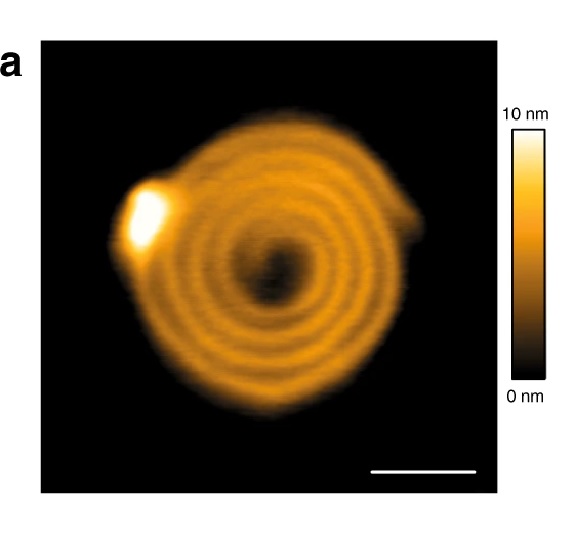In the article “Determination of polarization states in (K,Na)NbO3lead-free piezoelectric crystal” Mao-Hua Zhang, Chengpeng Hu, Zhen Zhou, Hao Tian, Hao-Cheng Thong, Yi Xuan Liu, Xing-Yu Xu, Xiao-Qing Xi, Jing-Feng Li and Ke Wang describe how polarization switching in lead-free (K0.40Na0.60)NbO3 (KNN) single crystals was studied by switching spectroscopy piezoresponse force microscopy (SS-PFM).*
Acquisition of multiple hysteresis loops on a closely spaced square grid enables polarization switching parameters to be mapped in real space. Piezoresponse amplitude and phase hysteresis loops show collective symmetric/asymmetric characteristics, affording information regarding the switching behavior of different domains. As such, the out-of-plane polarization states of the domains, including amplitudes and phases can be determined.*
The results presented by the authors could contribute to a further understanding of the relationships between polarization switching and polarization vectors at the nanoscale, and provide a feasible method to correlate the polarization hysteresis loops in a domain under an electric field with the polarization vector states.*
PFM and SS-PFM were implemented on a commercial Atomic Force Microscope using NanoWorld PlatinumIridium coated Pointprobe® EFM AFM probes.
![Fig. 1 from “Determination of polarization states in (K,Na)NbO3lead-free piezoelectric crystal” by Mao-Hua Zhang et al: PFM imaging and a schematic of tip movement during SS-PFM mapping. (a) Piezoresponse amplitude and (b) phase contrast images of the KNN single crystals. (c) In SS-PFM, local hysteresis loops are collected using a waveform at each pointon 25 × 25 mesh. The domain wall shown in Fig. 1(b) orients along [001]c.](https://dhipgo7nn2tea.cloudfront.net/wp-content/uploads/2020/07/25112255/figure-1-from-Mao-Hua-Zhang-et-al-2020-Determination-of-polarization-states-in-KNaNbO3lead-free-piezoelectric-crystal-NanoWorld-Pointprobe-EFM-AFM-probe-1-1-1024x536.jpg)
*Mao-Hua Zhang, Chengpeng Hu, Zhen Zhou, Hao Tian, Hao-Cheng Thong, Yi Xuan Liu, Xing-Yu Xu, Xiao-Qing Xi, Jing-Feng Li, Ke Wang
Determination of polarization states in (K,Na)NbO3lead-free piezoelectric crystal
Journal of Advanced Ceramics2020, 9(2): 204–209
DOI: https://doi.org/10.1007/s40145-020-0360-2
Please follow this external link to read the full article: https://link.springer.com/content/pdf/10.1007/s40145-020-0360-2.pdf
Open Access The article “Determination of polarization states in (K,Na)NbO3lead-free piezoelectric crystal” Mao-Hua Zhang, Chengpeng Hu, Zhen Zhou, Hao Tian, Hao-Cheng Thong, Yi Xuan Liu, Xing-Yu Xu, Xiao-Qing Xi, Jing-Feng Li and Ke Wang is licensed under a Creative Commons Attribution 4.0 International License, which permits use, sharing, adaptation, distribution and reproduction in any medium or format, as long as you give appropriate credit to the original author(s) and the source, provide a link to the Creative Commons license, and indicate if changes were made. The images or other third party material in this article are included in the article’s Creative Commons license, unless indicated otherwise in a credit line to the material. If material is not included in the article’s Creative Commons license and your intended use is not permitted by statutory regulation or exceeds the permitted use, you will need to obtain permission directly from the copyright holder. To view a copy of this license, visit http://creativecommons.org/licenses/by/4.0/.

